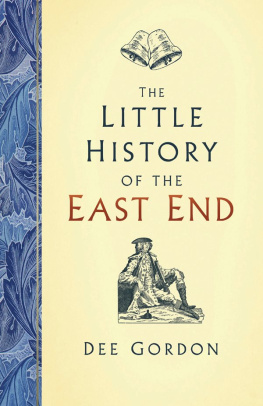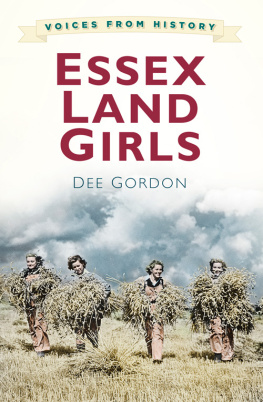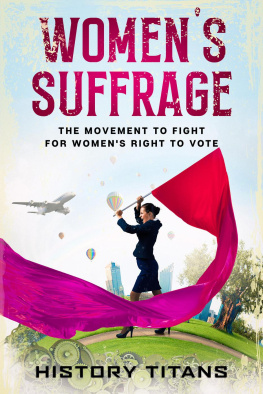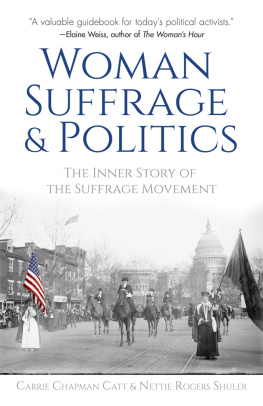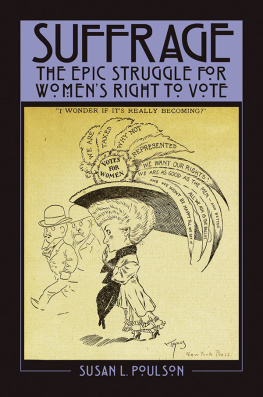Struggle and Suffrage in Southend-on-Sea
Struggle and Suffrage in Southend-on-Sea
Womens Lives and the Fight for Equality
Dee Gordon
First published in Great Britain in 2019 by
Pen & Sword HISTORY
An imprint of
Pen & Sword Books Limited
Yorkshire - Philadelphia
Copyright Dee Gordon, 2019
ISBN 978 1 52671 7 658
eISBN 978 1 52671 7 672
mobi ISBN 9781 52671 7 665
The right of Dee Gordon to be identified as Author of this work has been asserted by her in accordance with the Copyright, Designs and Patents Act 1988.
A CIP catalogue record for this book is available from the British Library
All rights reserved. No part of this book may be reproduced or transmitted in any form or by any means, electronic or mechanical including photocopying, recording or by any information storage and retrieval system, without permission from the Publisher in writing.
by TJ International Ltd, Padstow, Cornwall
Pen & Sword Books Limited incorporates the imprints of Atlas,
Archaeology, Aviation, Discovery, Family History, Fiction, History, Maritime,
Military, Military Classics, Politics, Select, Transport, True Crime, Air World,
Frontline Publishing, Leo Cooper, Remember When, Seaforth Publishing,
The Praetorian Press, Wharncliffe Local History, Wharncliffe Transport,
Wharncliffe True Crime and White Owl.
For a complete list of Pen & Sword titles please contact
PEN & SWORD BOOKS LIMITED
47 Church Street, Barnsley, South Yorkshire S70 2AS, United Kingdom
E-mail:
Website: www.pen-and-sword.co.uk
Or
PEN AND SWORD BOOKS
1950 Lawrence Rd, Havertown, PA 19083, USA
E-mail:
Website: www.penandswordbooks.com
Acknowledgements
The support of all those who have encouraged me to keep going when the research dried up (which happens!) has been invaluable among these were Denise Oanes, Donna Lowe and Chris Sternshine. Specific help was given by Jennifer Simpson, the late Lynn Tait (for permission to quote from The Tatler ), Lewis Herlitz, Carol Edwards, Judith Williams, Nigel Gayner, the staff at the Docklands Museum and the Womens Library, London, and at the Essex Record Office, Chelmsford. Photographs are from the authors collection, unless captioned otherwise.
Introduction
Between 1850 and 1950, the size and population of Southendon-Sea grew in line with the changes in the lives of women. Their lifestyles, aspirations, education and healthcare all underwent dramatic changes locally and are detailed in the chapters which follow. Dramatic does not understate the case when we remember that Victorian women had no rights over their children, lost control of their finances to their husbands on marriage, were unable to enter university, follow a profession or to vote. They could not even sue for divorce for adultery although men could and in the workplace, they had no protection from trade unions. The lives of working-class women in particular are almost ignored in social histories, and they do not feature in early portraits, other than perhaps as shadowy servants in the background. So while researching the invisible has proved difficult, it has proved fascinating and quite an eye-opener. Enjoy!
CHAPTER ONE
Women in Education
In the nineteenth century, educational opportunities especially for girls were limited. In fact, when Canon King arrived in Leigh-on-Sea with his wife and six children in 1859, they were most likely to have been schooled at home until around the age of 8. This was when the five boys (two born later) were boarded out. Such was the general pattern for middle class girls at the time, seen as wives-in-training.
However, as the population of Southend-on-Sea and the surrounding areas (from Shoeburyness to Leigh-on-Sea) grew following the arrival of the railway in 1855, so did the demand for schooling, no longer regarded as the privilege of the middle and upper classes. Victorians began to realise that schools could offer a broader curriculum and better facilities for their children than relying solely on a governess. Leighs Lady Olivia Sparrow endowed a national school in Leigh in 1834 and donated land for another in nearby Hadleigh in the 1850s, and Southends Squire Scratton granted land in Old Southend, near The Castle public house, for a national school in 1853, which opened c.1855. Southchurch National School, as it was known, had been preceded by a Dame school opposite Holy Trinity church (more of a cheap child-minding service) with the schoolmistress, Ann Arnold, also running the village shop and post office, and holding lessons at the back of her house. When the Southchurch school closed in 1948, no longer meeting the requirements of modern education, teacher Olive Goodale lost the job she had had for forty-five years (but she got another one pretty quickly in another school!). Another national school opened in 1868 in Prittlewell following local philanthropic donations of 500 towards the cost, and was described in the Chelmsford Chronicle of 29 May as a labour of love. These schools provided elementary education to the children of the poor in accordance with the teaching of the Church of England. Although the latter closed less than twenty years later due to lack of funding, by then the Nonconformists British School in the High Street had 200 children on its roll. There were a few religious schools offering some basic educational skills, but these attracted little voluntary custom.
Those who were unlucky enough to spend time in Rochford workhouse should have received three hours each day in reading, writing, arithmetic and Christian religion, but there is little evidence that this took place although girls probably avoided the cane, inflicted so readily on boys who stepped out of line. There is, however, a reference to a female industrial trainer being employed in 1882 at 25 p.a. to teach young women and girls the basics of needlework and domestic chores for domestic service. Access to local Sunday schools could also boost educational standards, with two-thirds of working-class children between the ages of 5 and 15 said to be attending these regularly by 1850.
The first school in the South Shoebury area was a large single room on Church Street, financed by local philanthropists and fundraisers from 1862. Eleanor Cox was the assistant teacher while her father was the Head. The schoolroom was replaced a decade or so later by Hinguar Street School on the same site and in 1886, a Board School was erected close by, with Jessie Grater as the first schoolmistress. North Shoebury children attended the National School which had been established prior to 1818 in Great Wakering, a few miles away. In 1873 the Sutton and Shopland Council (then serving a rural community, since swallowed up by development to the north of Southend) opened a school in Sutton for local children who were not obliged to work in the fields. One of the teachers was Mrs Thackeray, the wife of a well-known local vicar, who specialised in needlework and art. All these teachers had to be versatile, however, not just in the variety of subjects they needed to teach, but as regards the age group they were teaching.






